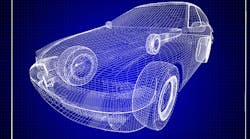Product Development Is Going Digital
Processes used to design and build cars and industrial equipment have typically followed a linear sequential path: Starting with product research and concept development, they move through design and development, prototype and validation, to production, launch, operation, and finally, product retirement.
But is this really the best way to proceed today?
With the Global 2000 spending $618 billion on research and development (R&D) a year, the ability to maximize the impact of the R&D spend has never been so important.
What we are seeing is a realization of the shortcomings of this linear approach. In particular, the inefficient flow of information throughout this process has shown to be a challenge.
What has started to emerge is a new approach by product development groups using digital business models, processes and tools. While the use of digital technology is not new in the auto industry, the way in which product developers are increasingly strategizing and executing their product development is. It spans manufacturing and product launches, using an all-digital perspective by using smarter technologies, actionable data, and creating better insights.
By embracing digital like never before, product developers will become fully integrated digital businesses and, therefore, well positioned to be more competitive.
What is the New Digital Model?
What is new is the highly integrated digital model with more frequent and varied information flow between processes. At the center of this network is digital product lifecycle management.
Product lifecycle management (PLM) encompasses all the processes involved in product development ranging from engineering, product development, supply chain management, manufacturing, services, and marketing.
Digital PLM elevates these PLM processes to higher levels of efficiency, productivity, and intelligence than the previous linear model. Conceptually, picture a square configuration with Digital PLM in the center. Surrounding this central hub on all four sides are all the processes previously used for traditional linear product development encompassing the product concept stage through product retirement.
This results in a highly interactive network with many more inter-connections than a linear model. The key difference, and inherent advantage, is information can flow back and forth between the central hub and all surrounding processes much more directly and efficiently. This allows for faster and more varied back and forth transmission of data, sharper insights, and, ultimately, better decisions.
Compared with the linear model, a Digital PLM model is more rapid, scalable, intelligent and connected. Capable of full-blown interactivity, these networks are rapid because they enable exceptional speed to market due to highly-improved planning and execution. They are scalable because they allow for seamless operations with unparalleled organization, flexibility and customization. They are intelligent because they leverage analytics and smart applications. And they are connected because they offer real-time visibility throughout the supply chain.
All this creates a more intelligent network than a linear model. Automotive and industrial equipment product developers that migrate towards a digital PLM network will gain competitive advantages such as:
- Unprecedented visibility to improve performance throughout the product value chain;
- Broader availability of dispersed data combined with advanced analytics capabilities;
- Exponential scalability; and
- Dramatically reduced speed to market
- Significant cost reduction by moving from physical to digital validation through use of virtual builds, simulation and testing
Trends Driving Digital PLM
Several technology trends are driving Digital PLM: analytics and big data, highly intelligent cyber physical systems or Digital Industry 4.0, cloud computing and social media.
Analytics and big data fuel data-driven insights and decisions.
Digital Industry 4.0 enables end-to-end offerings using converging digital technologies that enable smart, connected products that span physical and digital realms.
Mobile technology drives faster and better customer experiences.
Cloud computing enhances the infrastructure for connected products and nimble product development to be delivered faster and more economically.
Social media drives more collaboration with customers and suppliers by drawing on insights.
3-D printing, a type of manufacturing using digital models, has already proven of value in several manufacturing industries because it helps reduce production and development time. A major car manufacturer, for instance, has used this method to dramatically reduce the time to produce new engine parts.
Manufacturing industries are riding a new digital technology and business wave, underpinned by Digital Industry 4.0. Every business is a digital business, and all product development is going digital from end-to-end. Broader use of PLM will be critical to achieve high performance. Product developers need to think about their value chain for product development and launch, as well as their entire businesses, from a digital perspective. Their key strategic decisions and investments should be made with the intention of becoming digital in every way.






